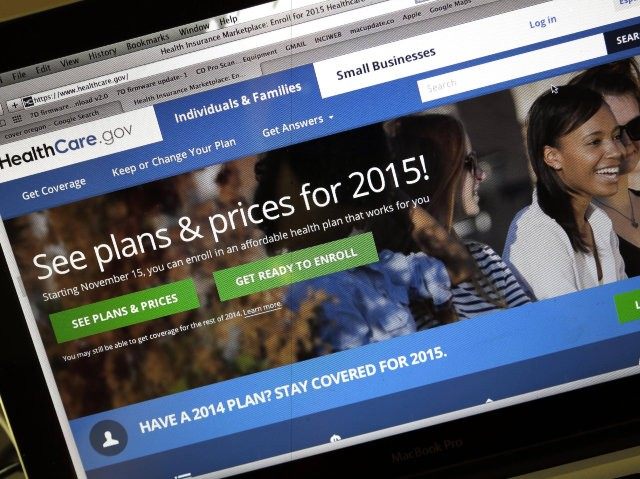Monday’s news of looming double-digit Obamacare premium increases will come as no surprise to those who have followed President Barack Obama’s myriad broken Obamacare promises.
However, the biggest failure and the most important impediment to the long-term sustainability of Obamacare is its inability to create and market a product that healthy people (especially young adults) want to buy without relying on tax credits.
As Breitbart’s John Hayward points out, to date, the majority of buyers of Obamacare are:
- People receiving large tax credits – it is not difficult to get someone to buy something if you give it to them for free or at a huge discount.
- People with pre-existing conditions – it is also not difficult to get someone to buy something they couldn’t buy before and now at a significantly lower price.
- People who had lost their plans because of Obamacare and who merely signed up for Obamacare as a replacement plan – often at higher costs and worse benefits.
Consequently, Obamacare has become more of an entitlement rather than an improved, affordable product people want to buy. And like most other products dependent on financial assistance to convince people to buy, Obamacare will fail to sustain itself long-term without significant ongoing government financial support.
So why aren’t healthy Americans buying Obamacare?
Put simply, from the consumers’ perspective, the costs and benefits don’t make sense. This may be a wise decision or an imprudent decision, but this is the decision that most healthy Americans that don’t qualify for tax subsidies are making. This is where the Obamacare product misses the mark; the product must provide affordable healthcare with easily recognizable benefits — not complicated healthcare insurance plans with uncertain, deferred benefits.
Two axial questions determine the cost for a medical item or service (e.g., hospital stay, physician visit, or prescription). First, what is the final cost of the medical item or service? Second, what is the cost-sharing agreement of this expense between the individual and their health insurance plan?
When marketing Obamacare, President Obama, Secretary Sebelius, HHS and Healthcare.gov almost exclusively focused on the second of these two elements — the cost-sharing between the patient and their insurance company. Unfortunately, cost sharing is a complicated and confusing calculation based on co-pays, co-insurance, deductibles, out-of-pocket limits, in-network vs. out-of-network and other family members year to date expenditures.
It is difficult if not impossible for anyone without significant prior experience with health insurance to understand and evaluate how these multiple caps, limits and percentages will actually benefit them, especially someone who has not previously had health insurance. In fact, Robert Laszewski of Health Policy and Strategy Associates was cited on Foxnews.com regarding this common public misimpression, stating, “You’re going to the doctor, you’re paying (a) premium, and because of this really high deductible, you’re not getting any benefits.”
For example, under Obamacare and our current healthcare system, if Warren Buffett goes to the doctor, the doctor charges him X. However, if later that day, a minimum wage earner with no health insurance goes to that same doctor and receives the exact same treatment, the doctor can charge the minimum wage earner 2x – 5x.
How is this possible? Because insurance companies negotiate maximum amounts they will pay for the costs of healthcare services with doctors, hospitals, and other health care providers in the insurance company’s network of healthcare providers. These negotiated amounts are known as the “allowed amount,” “eligible expense” or “negotiated rate.” Healthcare providers participating in a plan’s network agree to accept these payment amounts when a individual covered by the plan uses their services.
Therefore, in the Buffett example, Mr. Buffett’s doctor may only charge him $100 for the visit based on this negotiated “allowed amount.” Of this $100, Mr. Buffet would likely only pay a portion with the insurance company paying the balance. However, the minimum wage earner is charged the full non-discounted rate for that same visit — potentially $200 – $500 (in addition to getting no benefit from the insurance company paying some of the cost).
It is no wonder why people without insurance don’t go to the doctor unless they absolutely have to and often so late it requires them to go to more expensive emergency rooms. This system of different rates for the same product is principally absent from the focus of Obamacare and must be addressed in any replacement plan. Importantly, the benefit of a materially discounted rate from the original bill is a benefit that Americans considering buying insurance can and will understand and appreciate.
In the wake of the recent Supreme Court ruling, and with Obamacare projected to cost U.S. taxpayers $2.6 trillion in its first ten years, America is desperate for healthcare leadership. Without it, America’s healthcare crisis will grow unabated.
Obamacare is not the answer. What is needed is a product Americans want to buy, one based on common sense and easily understandable benefits and incentives. A program that forces people facing tough budget choices to purchase a product they don’t want to buy through penalties is a train wreck in the making. The time has come for Oblimination — the full scale dismantling of Obamacare and replacing it with a system based on free market principles that actually work.

COMMENTS
Please let us know if you're having issues with commenting.